the relation of habitual thought and behavior to language
the relation of habitual thought and behavior to language
the relation of habitual thought and behavior to language
Create successful ePaper yourself
Turn your PDF publications into a flip-book with our unique Google optimized e-Paper software.
RELATION OF HABITUAL THOUGHT AND BEHAVIOR TO LANGUAGE<br />
(or better 'eventing'), referred <strong>to</strong> in two<br />
ways, objective <strong>and</strong> subjective. Objectively,<br />
<strong>and</strong> only if perceptible physical<br />
experience, events are expressed mainly<br />
as outlines, colors, movements, <strong>and</strong> o<strong>the</strong>r<br />
perceptive reports . Subjectively, for both<br />
<strong>the</strong> physical <strong>and</strong> non-physical, events are<br />
considered <strong>the</strong> expression <strong>of</strong> invisible intensity-fac<strong>to</strong>rs,<br />
on which depend <strong>the</strong>ir stability<br />
<strong>and</strong> persistence, or <strong>the</strong>ir fugitiveness<br />
<strong>and</strong> proclivities. It implies that existents<br />
do not 'become later <strong>and</strong> later' all in <strong>the</strong><br />
same way ; but some do so by growing,<br />
like plants, some by diffusing <strong>and</strong> vanishing,<br />
some by a procession <strong>of</strong> metamorphoses,<br />
some by enduring in one shape<br />
till affected by violent forces . In <strong>the</strong> nature<br />
<strong>of</strong> each existent able <strong>to</strong> manifest as<br />
a definite whole is <strong>the</strong> power <strong>of</strong> its own<br />
mode <strong>of</strong> duration ; its growth, decline,<br />
stability, cyclicity, or creativeness . Everything<br />
is thus already 'prepared' for <strong>the</strong><br />
way it now manifests by earlier phases,<br />
<strong>and</strong> what it will be later, partly has been,<br />
<strong>and</strong> partly is in act <strong>of</strong> being so 'prepared .'<br />
An emphasis <strong>and</strong> importance rests on this<br />
preparing or being prepared aspect <strong>of</strong> <strong>the</strong><br />
world that may <strong>to</strong> <strong>the</strong> Hopi correspond <strong>to</strong><br />
that 'quality <strong>of</strong> reality' that 'matter' or<br />
'stuff' has for us .<br />
Habitual Behavior Features<br />
o f Hopi Culture<br />
Our <strong>behavior</strong>, <strong>and</strong> that <strong>of</strong> Hopi, can be<br />
seen <strong>to</strong> be coordinated in many ways <strong>to</strong><br />
<strong>the</strong> linguistically-conditioned microcosm .<br />
As in my fire case-book, people act about<br />
situations in ways which are like <strong>the</strong> ways<br />
<strong>the</strong>y talk about <strong>the</strong>m . A characteristic <strong>of</strong><br />
Hopi <strong>behavior</strong> is <strong>the</strong> emphasis on preparation<br />
. This includes announcing <strong>and</strong> getting<br />
ready for events well beforeh<strong>and</strong>,<br />
elaborate precautions <strong>to</strong> insure persistence<br />
<strong>of</strong> desired conditions, <strong>and</strong> stress on good<br />
will as <strong>the</strong> preparer <strong>of</strong> right results . Consider<br />
<strong>the</strong> analogies <strong>of</strong> <strong>the</strong> day-counting<br />
2 07<br />
pattern alone. Time is mainly reckoned<br />
'by day' (talk, -tala) or 'by night' (<strong>to</strong>k),<br />
which words are not nouns but tensors,<br />
<strong>the</strong> first formed on a root 'light, day,' <strong>the</strong><br />
second on a root 'sleep .' The count is by<br />
ordinals . This is not <strong>the</strong> pattern <strong>of</strong> counting<br />
a number <strong>of</strong> different men or things,<br />
even though <strong>the</strong>y appear successively, for<br />
even <strong>the</strong>n <strong>the</strong>y could ga<strong>the</strong>r in<strong>to</strong> an assemblage.<br />
It is <strong>the</strong> pattern <strong>of</strong> counting successive<br />
reappearances <strong>of</strong> <strong>the</strong> same man or<br />
thing, incapable <strong>of</strong> forming an assemblage.<br />
The analogy is not <strong>to</strong> behave about daycyclicity<br />
as <strong>to</strong> several men ('several days'),<br />
which is what we tend <strong>to</strong> do, but <strong>to</strong> behave<br />
as <strong>to</strong> <strong>the</strong> successive visits <strong>of</strong> <strong>the</strong> same<br />
man. One does not alter several men by<br />
working upon just one, but one can prepare<br />
<strong>and</strong> so alter <strong>the</strong> later visits <strong>of</strong> <strong>the</strong><br />
same man by working <strong>to</strong> affect <strong>the</strong> visit<br />
he is making now. This is <strong>the</strong> way <strong>the</strong><br />
Hopi deal with <strong>the</strong> future-by working<br />
within a present situation which is expected<br />
<strong>to</strong> carry impresses, both obvious<br />
<strong>and</strong> occult, forward in<strong>to</strong> <strong>the</strong> future event<br />
<strong>of</strong> interest . One might say that Hopi society<br />
underst<strong>and</strong>s our proverb 'Well begun<br />
is half done,' but not our To-morrow<br />
is ano<strong>the</strong>r day.' This may explain<br />
much in Hopi character .<br />
This Hopi preparing <strong>behavior</strong> may be<br />
roughly divided in<strong>to</strong> announcing, outer<br />
preparing, inner preparing, covert participation,<br />
<strong>and</strong> persistence. Announcing,<br />
or preparative publicity, is an important<br />
function in <strong>the</strong> h<strong>and</strong>s <strong>of</strong> a special <strong>of</strong>ficial,<br />
<strong>the</strong> Crier Chief . Outer preparing is preparation<br />
involving much visible activity, not<br />
all necessarily directly useful within our<br />
underst<strong>and</strong>ing . It includes ordinary practising,<br />
rehearsing, getting ready, introduc<strong>to</strong>ry<br />
formalities, preparing <strong>of</strong> special food,<br />
etc . (all <strong>of</strong> <strong>the</strong>se <strong>to</strong> a degree that may<br />
seem over-elaborate <strong>to</strong> us), intensive sustained<br />
muscular activity like running, racing,<br />
dancing, which is <strong>thought</strong> <strong>to</strong> increase











